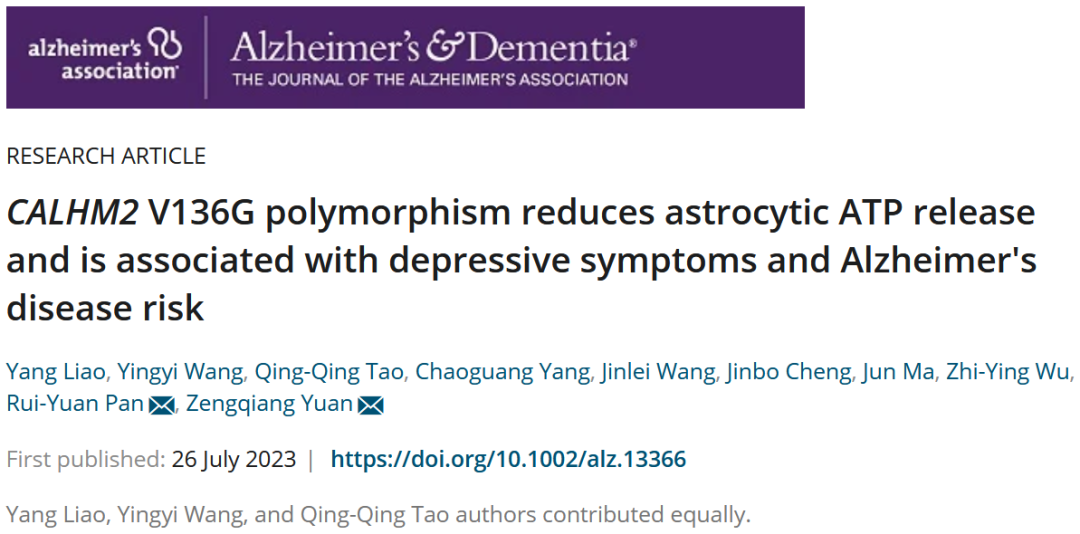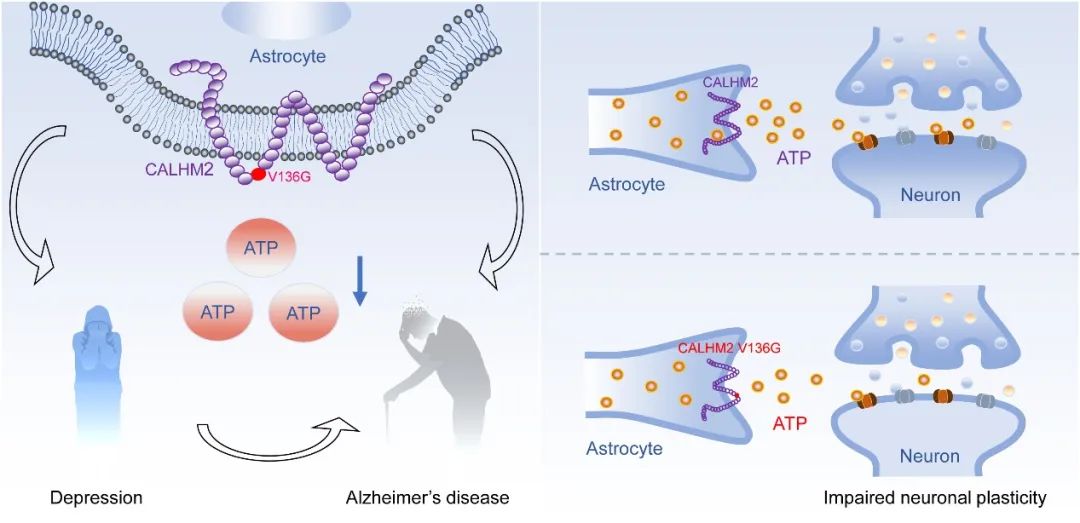
Source: BioArtMED
Depression and Alzheimer's disease are the most common major brain diseases in young and old people respectively, and there is a serious lack of clinical treatment for these two major brain diseases. Many long-term clinical follow-up studies have shown that people who experience depression early in life have a significantly increased risk of developing Alzheimer's disease later in life, suggesting that depression is an independent risk factor that promotes Alzheimer's disease. However, although the clinical correlation between depression and Alzheimer's disease has been reported for many years, the cellular and molecular mechanisms by which depression contributes to the development of Alzheimer's disease have been unclear.
Calcium homeostasis regulatory protein (CALHM) is a voltage-dependent calcium channel with a quaternary transmembrane structure, and is also an important channel mediating ATP release from cells. Therefore, CALHM protein plays an important role in maintaining mammalian physiological functions. CALHM protein dysfunction has been shown to contribute to a variety of neuropsychiatric disorders, including depression and Alzheimer's disease (AD, the main form of Alzheimer's disease).
Yuan Qiangsheng's research group from the Academy of Military Medical Sciences has been committed to the study of the function of CALHM protein for a long time, and for the first time found that Calhm2 protein is a calcium-dependent ATP release channel, and found that it is significantly decreased in the brain of depression-like mouse models. The lack of Calhm2 will lead to a significant decrease in the release of ATP from astrocytes in the brain. It then leads to depression-like behavior in mice (Ma et al., Mol Psychiatry. 2018). The Calhm2 Q87A mutation was found to significantly increase susceptibility to depression and summarized the role of astrocytes in depression and AD (Liao et al., PIBB. 2021; Liao et al., Front Med. 2021); In addition, Yuan Zengqiang's team also found that Calhm2 is closely related to the occurrence of AD, and microglia-specific knockout of Calhm2 can reduce neuroinflammation in 5XFAD mice, thereby improving the cognitive function of AD mice (Cheng et al., Sci.Adv.2021). These findings suggest that Calhm2 may be an important target linking depression and Alzheimer's disease.
Recently, The research team of Yuan Zengqiang from the Academy of Military Medicine published the title CALHM2 V136G polymorphism reduces astrocytic ATP release and is online in Alzheimer's & Dementia, a top journal in the field of AD associated with depressive symptoms and Alzheimer's disease risk, CALHM2 V136G mutation was found to be involved in depression and Alzheimer's disease by regulating ATP release from astrocytes. The cellular and molecular mechanisms by which depression as an independent risk factor promotes the development of AD have been revealed for the first time, providing potential drug targets for the comorbidity treatment of depression and AD.

In this study, Yuan Qiangqiang's team and Wu Zhiying's team from the Second Affiliated Hospital of Zhejiang University jointly analyzed the single nucleotide polymorphism (SNP) of AD patients samples from Chinese Han population and found that the SNP rs232660 in CALHM2 was significantly increased (about 2 times) in AD patients from Chinese Han population. The SNP rs232660 causes the substitution of valine for glycine (V136G) at the 136th amino acid site. Further studies showed that the V136G mutation damaged the ATP release channel properties of CALHM2 protein and was a loss of function mutation. Sequence comparison showed that CALHM2 was highly conserved in many species such as humans and mice.
To further investigate the function of this mutation in vivo, the researchers constructed Calhm2 V136G knock in mice. Using a variety of cellular, molecular, biochemical, and ethological tests, the researchers found that the V136G mutation led to a decrease in ATP release from astrocytes, which led to depression-like behavior in mice. Exogenous ATP supplementation can significantly alleviate depression-like behavior in Calhm2 V136G mutant mice.
What's more, the researchers found that Calhm2 V136G mice that were chronically depressed developed more severe cognitive dysfunction in old age (18 months of age) than normal mice. These findings suggest that CALHM2 may be a key target linking depression and Alzheimer's disease, explaining an important clinical phenomenon in which depression promotes Alzheimer's disease as an independent risk factor.
 Figure 1. Model of CALHM2 V136G's involvement in depression and AD development
Figure 1. Model of CALHM2 V136G's involvement in depression and AD development
Researcher Yuan Qiangqiang from the Academy of Military Medicine and Professor Pan Ruiyuan from Southern Medical University (former postdoctoral fellow of Yuan Qiangqiang's research group) are the co-corresponding authors of this work, and master's student Liao Yang (graduated and now a PhD student in Central South University), doctoral candidate Wang Yingyi and Director of the Second Affiliated Hospital of Zhejiang University Tao Qingqing are the co-first authors.
The original link: https://doi.org/10.1002/alz.13366